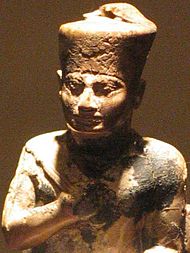The Great Pyramid
Khufu and Nesut-Westert 2570 BC
The Egyptian king Khufu (2589-2566 BC, according to the ptolmeic historian Manetho) leveraged the pyramid building tradition of his predecessors to create a mausoleum on an unprecedented scale. Archaeology and modern scholarship indicate that the builders were skilled workers with a level of prestige in Egyptian society. The tomb of the overseer of the pyramid's construction, Nesut-Westert, has been located, and his sarcophagus was opened in 2002.

The organisational task was immense, involving the sourcing, shaping, moving and accurate arrangement of 2.3 million stone blocks, weighing up to 15 tons each. Evidence shows that many of the large-scale aspects of the project were scaled up from things the Egyptians already knew how to do by simply repeating work units many times over. For instance the bakeries used to feed the workers were not particularly large, but there were a great many of them.
The workforce was divided into crews of 2000 men, which were divided into 1000 man gangs, each with its own nickname, such as the "Drunkards of Menkaure". Each gang had five phyles of 200 men, which carried the names "Great", "Asiatic", "Green", "Little" and "Last". Finally the phyles were split into divisions of 20 men, each with a leader. It is thought that work was stepped up when the Nile flooded and agricultural activity was suspended. The supply chain of food, materials and tools was correspondingly huge and accounting methods were sophisticated.
